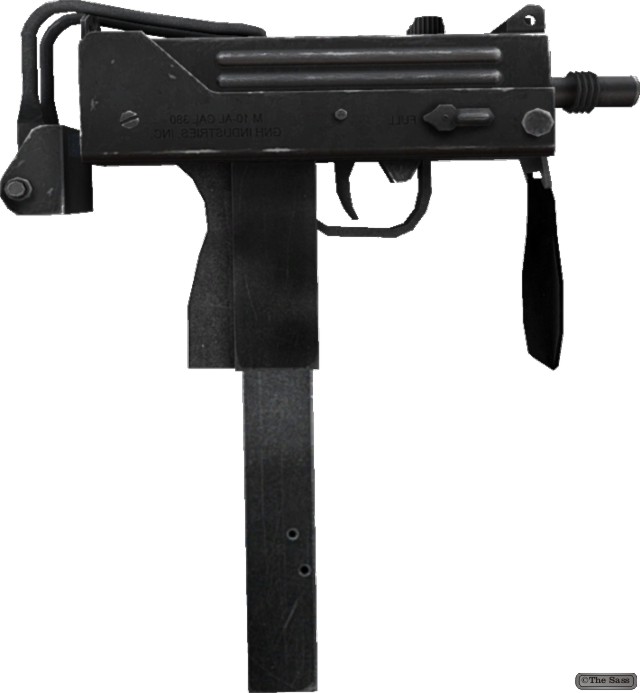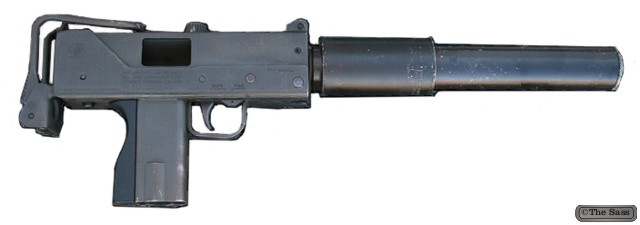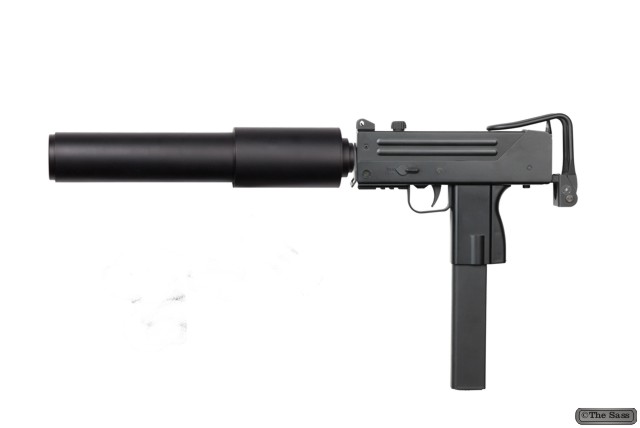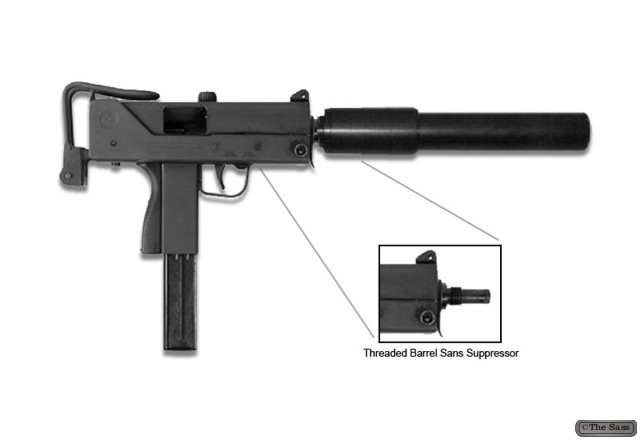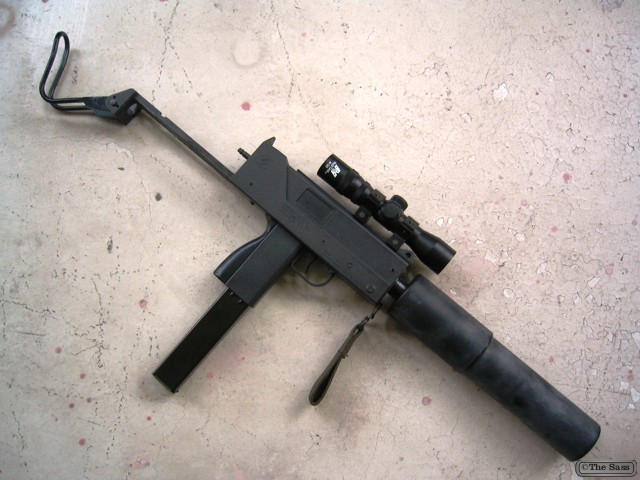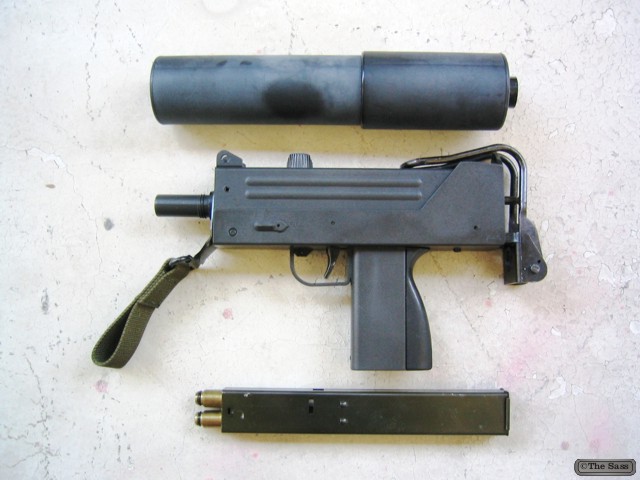Ingram MAC-10
The MAC-10 (Military Armament Corporation Model 10, officially the M-10) is a compact, blowback operated machine pistol developed by Gordon B. Ingram in 1964. It is chambered in either .45 ACP or 9mm. A two-stage suppressor by Sionics, was designed for the MAC-10, which not only abated the noise created, but made it easier to control on full automatic.
Design
The M-10 was built predominantly from steel stampings. A notched cocking handle protrudes from the top of the receiver, and by turning the handle 90° would lock the bolt, and act as an indicator that the weapon is unable to fire. The M-10 has a telescoping bolt, which wraps around the barrel. This allows a more compact weapon, and balances the weight of the weapon over the pistol grip where the magazine is located. The M-10 fires from an open bolt, and the light weight of the bolt results in a rapid rate of fire. In addition, this design incorporates a built in feed ramp as part of the trigger guard (a new concept at the time) and to save on cost the magazine was recycled from the M3 Grease Gun. The barrel is threaded to accept a suppressor, which worked by reducing the discharge’s sound, without attempting to reduce the velocity of the bullet. At the suggestion of the United States Army, it also acted as a foregrip to inhibit muzzle rise when fired. Ingram added a small bracket with a small strap beneath the muzzle to aid in controlling recoil during fully automatic fire. The original rate of fire for the M-10 in .45 is approximately 1090 rounds per minute. That of the M11/nine 9mm is approximately 1250 rounds per minute, and that of the M11 .380 is 1380 rounds per minute.
Suppressor
The primary reason for the original M-10 finding recognition was its revolutionary sound suppressor designed by Mitchell Werbell III of Sionics. This suppressor had a two-stage design, with the first stage being larger than the second. This uniquely shaped suppressor gave the MAC-10 a very distinctive look. It was also very quiet, to the point that the bolt could be heard cycling, along with the suppressed report of the weapon’s discharge; however, only if subsonic rounds were used. The suppressor when used with a Nomex cover created a place to hold the firearm with the secondary hand, making it easier to control. During the 1970s the United States placed restrictions on the exportation of suppressors, and a number of countries canceled their orders of M-10s as the effectiveness of the MAC-10’s suppressor was one of its main selling points. This was one factor that led to the bankruptcy of Military Armament Corporation, another being the company’s failure to recognize the private market. The original Sionics suppressor is 11.44 inches in length, 2.13 inches in overall diameter, and weighs 1.20 pounds.
Nomenclature
The term “MAC-10” is commonly used, but unofficial, parlance. Military Armament Corporation never used the nomenclature MAC-10 on any of its catalogs or sales literature, but because “MAC-10” became so frequently used by Title II dealers, gun writers, and collectors, it is used more frequently than “M10” to identify the gun.
Calibers and Variants
While the original M-10 was available chambered for either .45 ACP or 9mm, the M-10 is part of a series of machine pistols, the others being: the MAC-11 / M-11A1 semi, which is a scaled down version of the M-10 chambered in .380 ACP; and the M-11/9, which is a modified version of the M-11 with a longer receiver chambered in 9mm, later made by SWD (Sylvia and Wayne Daniel), Leinad and Vulcan Armament.
In the United States, machine guns are National Firearms Act items. As Military Armament Corporation was in bankruptcy large number of incomplete sheet metal frame flats were given serial numbers then bought by a new company, RPB industries. Some of the previously completed guns (already stamped MAC), were stamped on the other side RPB, making a “double stamp” gun.
RPB Industries made many open-bolt semi-automatic and sub-machine guns before the Bureau of Alcohol Tobacco and Firearms (abbreviated ATF) seized roughly 200 open bolt semi autos during the drug wars of 1981. ATF insisted that all future semiautomatic versions were to be manufactured with a closed-bolt design as the open-bolt semiautomatics were considered too easy to illegally convert to full automatic operation.
Wayne Daniel, a former RPB machine operator, purchased much of their remaining inventory and formed SWD, designing a new weapon which was more balanced, available either fully or semi-automatic with his new ATF approved closed bolt design.
There are several carbine versions of the M-11/9 and Cobray and SWD manufactured a smaller version chambered in .380 ACP as a semiautomatic pistol called the M-12.
Today, while the civilian manufacture, sale and possession of post 1986 select-fire MAC-10 and variants is prohibited it is still legal to sell templates, tooling and manuals to complete such conversion. These items are typically marketed as being “post-sample” materials for use by Federal Firearm Licensees for manufacturing/distributing select-fire variants of the MAC-10 to Law Enforcement, Military and Overseas customers.
The Sass

